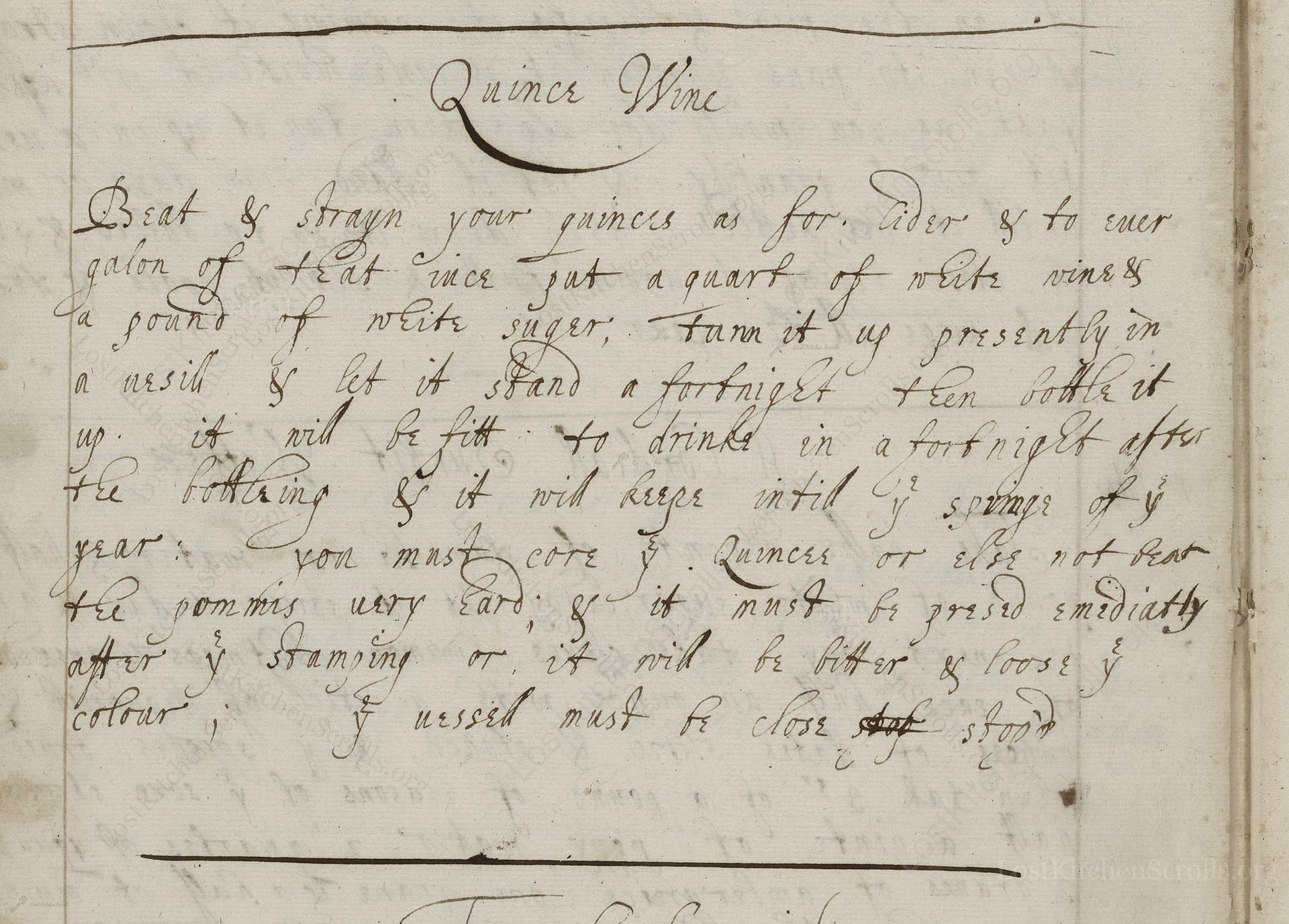Quince Wine
From the treasured pages of Receipt book of Rebeckah Winche
Written by Rebecca Winch

Quince Wine
"Beat & Strayn your quinces as for. Cider & to euery galon of that Juice put a pound of white sugar & a quart of white wine & water. Turn it up presently in a uesell & let it stand a fortnight then bottle it up. It will be fit to drinke in a fortnight after the bottling & it will keepe untill the spring of the year. you must core the Quinces or else not beat the pommis very hard, & it must be presed imediattly after the straming or it will be bitter & loose the colour; & the uessell must be close stopd"
Note on the Original Text
The original recipe’s sparse instructions assume the reader’s prior experience with cider-making—a popular rural pastime. Early modern recipes omit precise measurements, relying on ratios ('per gallon') and subjective guidance ('not beat the pommis very hard'). Spelling is idiosyncratic—‘Strayn’ for strain and ‘uesell’ for vessel—reflecting the inconsistencies of 17th-century English. The recipe warns against delays (to prevent bitterness) and stresses the importance of keeping the vessel tightly closed to avoid spoilage, echoing practical household wisdom of the era.

Title
Receipt book of Rebeckah Winche (1666)
You can also click the book image above to peruse the original tome
Writer
Rebecca Winch
Era
1666
Publisher
Unknown
Background
Step into the 17th-century kitchen with Rebecca Winch, where hearty feasts and time-honored recipes whisper secrets of early English cooking. From savory pies to delicate sweets, this charming volume offers a sumptuous glimpse into culinary history.
Kindly made available by
Folger Shakespeare Library
This recipe hails from the English household of Rebecca Winch, who lived in the late 17th century. Quince wine was a precious homemade beverage, prepared at harvest time when quinces were abundant. Due to their tough texture and tangy flavor, quinces were rarely consumed raw but prized for preserves and cordials. This recipe typifies early modern English ingenuity in transforming orchard fruit into festive drinks, long before commercial wines were widely available. The instructions reflect a period when domestic brewing and fermenting were common pursuits, extending the life of perishable fruit through creative preservation techniques that also delighted the palate.

Seventeenth-century kitchens relied on large mortars and pestles or wooden beaters to crush quinces, then passed the pulp through loosely woven cloth or a horsehair strainer. A screw press—a hefty kitchen tool—was used to extract every drop of juice. Fermentation happened in earthenware or wooden vessels, sealed with cloth, animal bladder, or waxed leather to limit air exposure. Bottling involved glass bottles sealed with cork or wax.
Prep Time
30 mins
Cook Time
0 mins
Servings
6
We've done our best to adapt this historical recipe for modern kitchens, but some details may still need refinement. We warmly welcome feedback from fellow cooks and culinary historians — your insights support the entire community!
Ingredients
- 2.2 lbs ripe quinces, cored (substitute: hard pears, if quinces unavailable)
- 1/2 lb white sugar
- 1 cup dry white wine
- 3 1/4 cups water
Instructions
- Begin by selecting ripe quinces.
- Core them carefully, then grate or roughly chop before crushing, much as you would apples for cider.
- Immediately press the pulp to extract juice; measure out 1 quart of quince juice for every batch.
- For each quart, add 1/2 pound of white sugar.
- Stir in 1 cup of dry white wine, and top up with 3 1/4 cups of water, blending well.
- Transfer this mixture at once into a fermentation vessel—ideally a glass demijohn—ensuring it is well-sealed with an airlock to keep the atmosphere anaerobic.
- Allow this to ferment for 14 days (a fortnight).
- After this initial fermentation, bottle the wine, seal well, and leave undisturbed for another 14 days.
- The resulting quince wine is ready to drink, though it improves through the spring months.
- Take care to press the juice at once, as delayed pressing makes the wine bitter and dull in color.
Estimated Calories
140 per serving
Cooking Estimates
Preparing the quinces takes about 30 minutes. There is no actual cooking, but fermentation takes about 28 days. This recipe makes about 1 liter of wine, or about 6 servings of a standard 150 ml glass each. Each serving has about 140 calories.
As noted above, we have made our best effort to translate and adapt this historical recipe for modern kitchens, taking into account ingredients nowadays, cooking techniques, measurements, and so on. However, historical recipes often contain assumptions that require interpretation.
We'd love for anyone to help improve these adaptations. Community contributions are highly welcome. If you have suggestions, corrections, or cooking tips based on your experience with this recipe, please share them below.
Join the Discussion
Rate This Recipe
Dietary Preference
Main Ingredients
Culinary Technique

Den Bockfisch In Einer Fleisch Suppen Zu Kochen
This recipe hails from a German manuscript cookbook compiled in 1696, a time whe...

Die Grieß Nudlen Zumachen
This recipe comes from a rather mysterious manuscript cookbook, penned anonymous...

Ein Boudain
This recipe comes from an anonymous German-language manuscript cookbook from 169...

Ein Gesaltzen Citroni
This recipe, dating from 1696, comes from an extensive anonymous German cookbook...
Browse our complete collection of time-honored recipes



